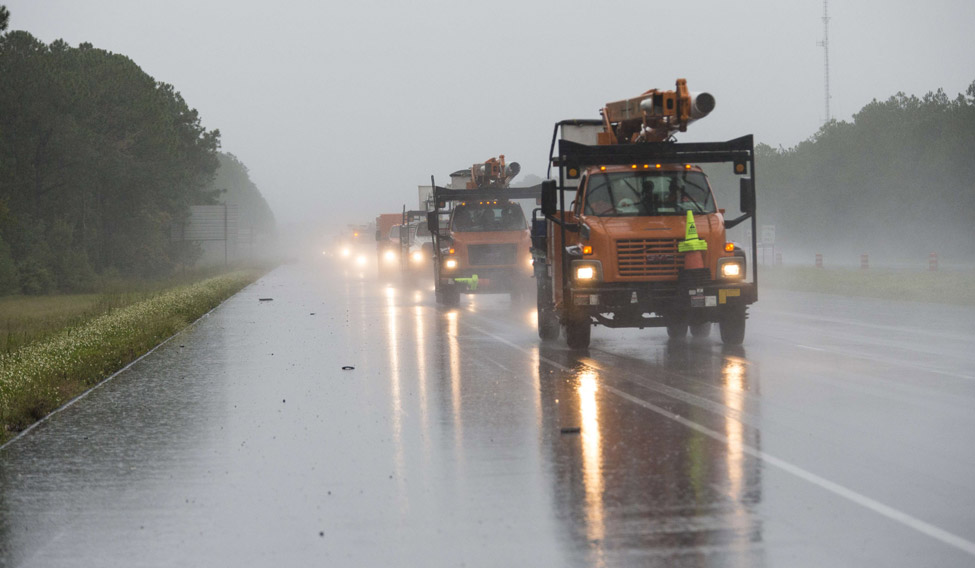Hurricane Nate slammed the Mississippi Coast on Sunday with destructive winds and torrential rains that flooded streets and highways throughout the region as the fast moving Category 1 storm made landfall.
Nate, the fourth major storm to strike the United States in less than two months, killed at least 30 people in Central America before entering the warm waters of the Gulf of Mexico and bearing down on the US South. It has also shut down most oil and gas production in the Gulf.
Nate comes on the heels of three other major storms, Harvey, Irma and Maria, which devastated Texas, Florida and Puerto Rico, respectively. However, with winds of 85 miles per hour (135 km per hour), which make it a Category 1 storm, the weakest in the five-category ranking used by meteorologists, Nate appeared to lack the devastating punch of its predecessors.
The National Hurricane Center (NHC) downgraded its warning for New Orleans to a tropical storm. But Nate was expected to regain some strength and make a second landfall along the coast of Mississippi to the east.
“The only thing you can do is prepare,” said Gulfport, Mississippi, resident Emmett Bryant. “Here there’s nothing really you can do when the storm comes unless you’re going to leave. And I don’t plan on leaving.”
The hurricane’s center was expected to pass over portions of Mississippi, Alabama, and Tennessee through Sunday night, eventually weakening to a tropical depression. Before then, storm surges of up to 11 feet (3.4 m) on the Mississippi-Alabama border were possible, the NHC said.
In Hancock County, Mississippi, northeast of New Orleans, rain and wind were gaining intensity and many streets were washing over. Conditions are likely to worsen in the next few hours, said Brian Adam, director of emergency management for the county.
The county evacuated people from low-lying areas and imposed a curfew.
The storm surge brought flood waters over Highway 90 and up to ocean-side casinos in Biloxi, Mississippi, while flood waters swept over streets in communities across Mississippi and Alabama, according to reports on social media.
“We have a restaurant and one of our main bars open so they have been ok so far,” Chett Harrison, the general manager at the Golden Nugget hotel and casino in Biloxi where 300 guests were hunkered down, told a local CBS TV affiliate. “No one has tried to leave thank goodness because everything is flooded around us.”
Biloxi warned its 46,000 residents that the highest storm surge would occur until 3 am Sunday and could reach 11 feet to 12 feet.
Earlier in the day, states of emergency were declared in Louisiana, Mississippi and Alabama, as well as in more than two dozen Florida counties.
In Alabama, Governor Kay Ivey urged residents in areas facing heavy winds and storm surges to take precautions.
Some 5,000 people in southern Alabama were without power due to Nate, Alabama Power said.
Rainfall amounts of 3 inches to 6 inches (7.6 cm to 15.2 cm), up to a maximum of 10 inches were expected east of the Mississippi River from the central Gulf Coast into the Deep South, in the eastern Tennessee Valley, and southern Appalachian mountains, the NHC said.
Rainfall in the Ohio Valley and into the central Appalachians could be 2 inches to 5 inches with a maximum of 7 inches.
NEW ORLEANS THREAT DOWNGRADED
New Orleans Mayor Mitch Landrieu lifted a curfew in the city on Saturday evening that was originally scheduled to last until Sunday morning. He said in a statement on social media however, that there was still a serious threat of storm surge outside levee areas.
Plaquemines Parish south of New Orleans evacuated some 240 residents who were not protected by its levee system as the storm approached.
“While it appears we’re being spared ... our hearts go out to Mississippi,” said Amos Cormier, president of Plaquemines Parish, a low-lying area south of New Orleans.
Major shipping ports across the central US Gulf Coast were closed to inbound and outbound traffic on Saturday, as Nate intensified and storm surges of up 11 feet were expected at the mouth of the Mississippi River.
The storm has curtailed 92 per cent of daily oil production and 77 per cent of daily natural gas output in the Gulf of Mexico, more than three times the amount affected by Harvey.
Workers had been evacuated from 301 platforms and 13 rigs as of Saturday, said the US Bureau of Safety and Environmental Enforcement.
Before heading north into the Gulf, Nate brushed Mexico’s Yucatan peninsula, home to beach resorts such as Cancun and Playa del Carmen, the NHC said.
The storm doused Central America with heavy rains on Thursday, killing at least 16 people in Nicaragua, 10 in Costa Rica, two in Honduras and two in El Salvador.
Thousands were forced to evacuate their homes and Costa Rica’s government declared a state of emergency.
―Reuters





